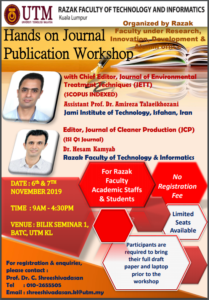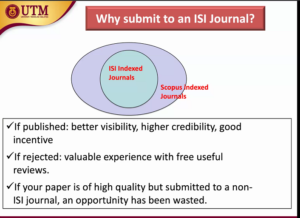Hands on Journal Publication Workshop with Chief Editor

Hands on Journal Publication Workshop
If your research is not published in a journal it does not exist – it must be possible to find it because your paper is your passport to the community. There are 3 necessary steps in useful research:
- First is to begin with it
- Second is to end with it
- Third is to publish it
Review article (chapter 2)
Critical synthesis of a specific research topic – 8000-12,000 words
Original article
Disseminating completed research findings – 6000 – 8000 words with references. Choose the appropriate journal to build a scientific research career
TOC in Original Article
1. Title – must be catchy & spicy. Be honest & concise. the content must at par with the tittle. Make sure cover all the keyword. Less than 15 words.
2. Abstract – no technical jargon, standalone, 4W1H.
3. Keyword – repeatitive of the words so the manuscript to be easily found online and cited. should be specific, avoid uncommon abbrevieations and general terms. more than 85 repeatition should be keyword. the journal appointed reviewer based on the keywords. Not more than 5 keywords and abbs the establish one.
3. Introduction – the most difficult.
i Start by general aspect then go down to specific to your research.
ii. Flow must consistent between paragraph.
iii. Must have Statements that indicate the need for more investigation.
iv. Introduction should start with the problem in that case.
4. Study area/background (easy)
5. Methods (easy)
6. Results (easy-just the facts)
7. Discussion (second most difficult) – good paper will have good discussion.
8. Conclusions (what have done in your study) – easy. Avoid repeatition with other sections, overly speculative.
9. Acknowledgements – anyone who helped you, sources of funding. e.g. grant or reference numbers.
10. Figure 5-6 and tables 4 is appropriate. Dont put too many in one paper.
Level of difficulty
- Conference
- Non-indexed journal
- Indexed Journal
- A journal is indexed when its bibliographic and citation information is included by the citation data supplier – set turnitin similarity indexed to 0 ( I dont understand, need to check with Librarian).
- Overlapped with
- Impact factor is an annual measure of the extent to which articles in that journal are cited. It can be calculated as follows:
- Research Uni – ISI (Web of Science) and Scopus.
- ISI founded in 1960 and becoming WoS
Criteria for choosing a journal
- Scope of journal
- Indexing
- Impact factor (IF)
- number of citations that articles in the journal have received within a specific time.
-
IF=CITATIONS/ARTICLES PUBLISHED (in two years)5 year impact factor=IF in five years(sum of citations in 5 years/articles published in five years)yearly IF= IF in one year.
- Journal ranking
- Q1 & Q2 – highest quality paper
- Publication frequency
- Time to publish.
Tips to publish
- Journal selection Process
- Target 3-5 possible journal
- Choose the journal that matches the quality of journal
- Factors to consider – scope of journal, journal indexing database.

e.g. IEEE, Elsevier – high rank & top view
- http://journalfinder.elsevier.com –
- Enter title and abstract of your paper to easily find journals that could be best suited for publishing. JournalFinder uses smart search technology and field-of-research specific vocabularies to match your paper to scientific journals.
- Most downloaded papers – use it in your journal references.
- How to increase the visibility – Publish papers in somewhere pay (elsevier, IEEE) then put into researchgate so people can easily download without pay.
- Enhance your writing by:
- Critical review for thesis chapter 2 (LR)
- Finding the Gap of the study
- Novelty of the study
- Build an expertise area.
- Submitting the paper – traditional submission (email) via a journal online submission – include the cover letter (very important) – contain authors’ rationale.
- Cover letter is important. Example of cover letter:
- for choosing the editors’s journal. The letter can suggest reviewer.
- The peer review process – Editors to the reviewers to review. Then the reviewer will recommend – reject, revise, accept. Managing editor – involve in clerical and administrative detail in the review process. Makes some preliminary decisions.
- Initial screening – language, content.
- Review process from 1 hr to 6 months. 1-4 reviewers along with editorial comments. Proof preparation for checking by authors. In press/queue/article in press.
- Reviewers comment – after taking the considerations matter above – publish or reject!
- Some of the good criteria – title must be good, then get unique methods or result is something interesting, new and novelty idea.
- Addressing reviewers comment
- not being out rightly rejected
- make sure address everything
- If it is rejected – at least give some feedback
Social Network for Academic
- Research gate
- Academia Ed
- ORCID
- Google scholar
- Scopus profile Rdsearch ID profile
- Pubfacts profile
- Publons profile
